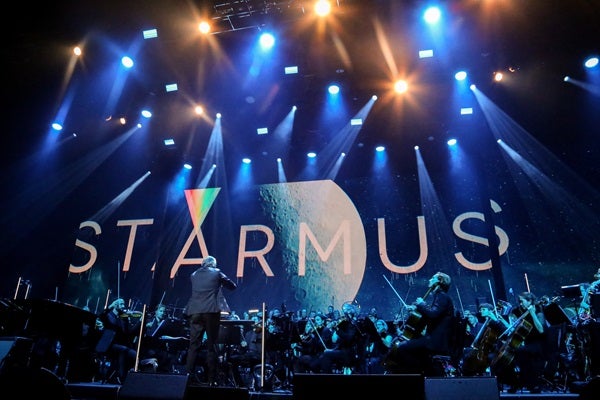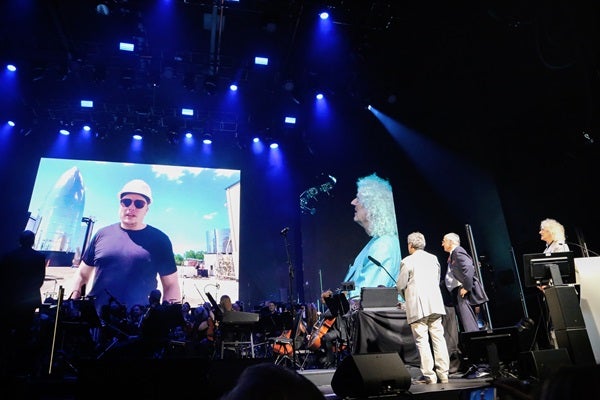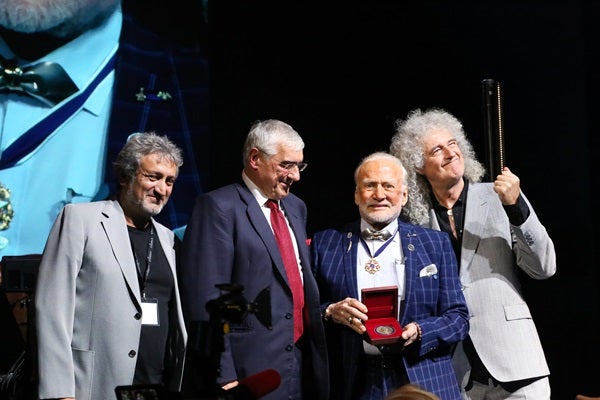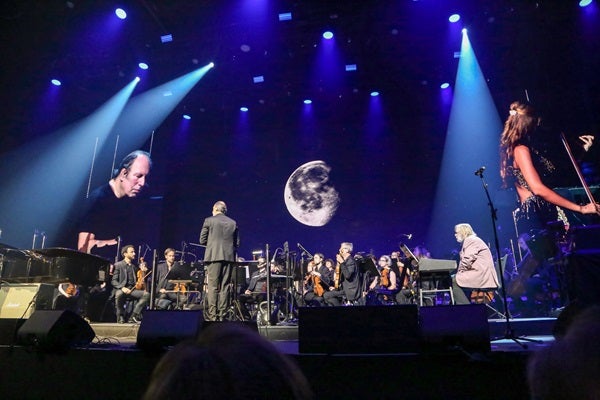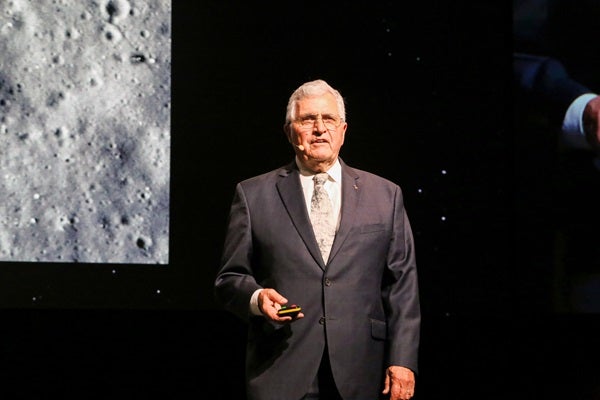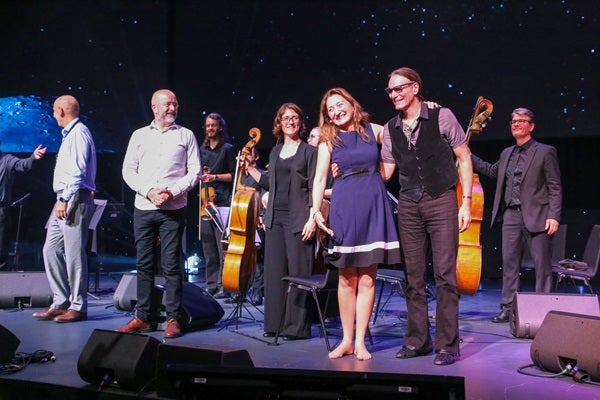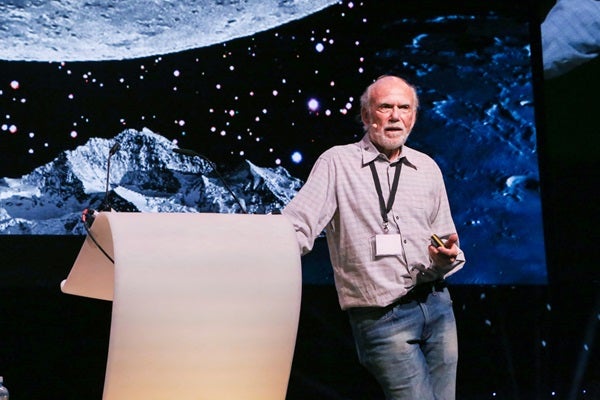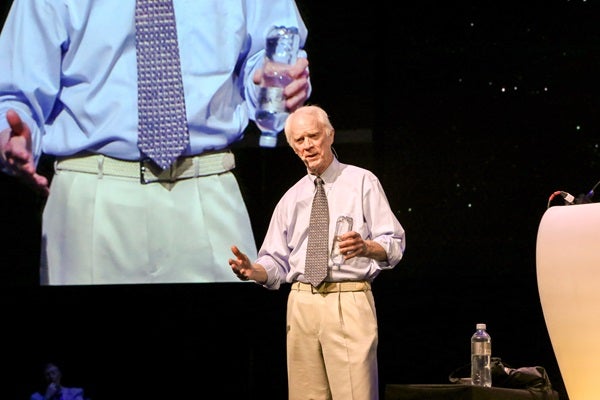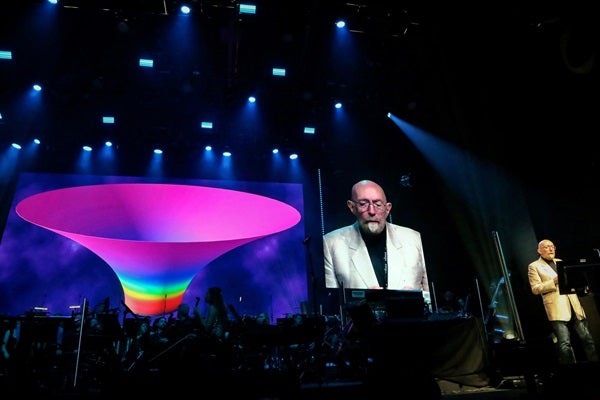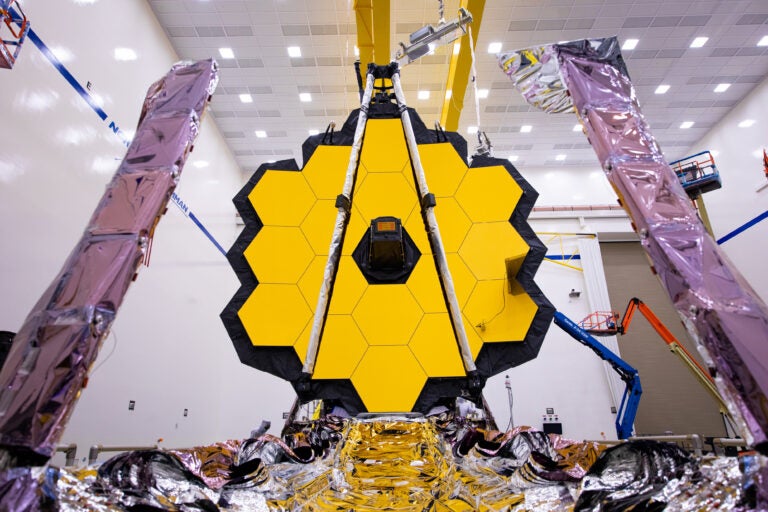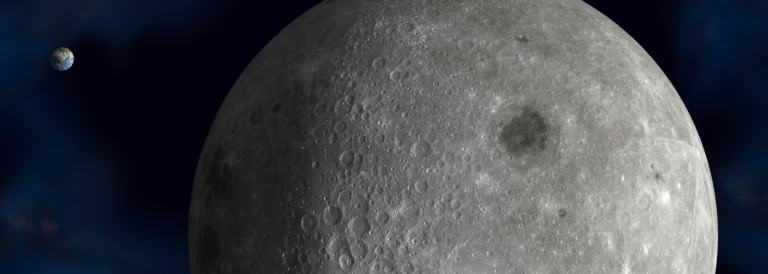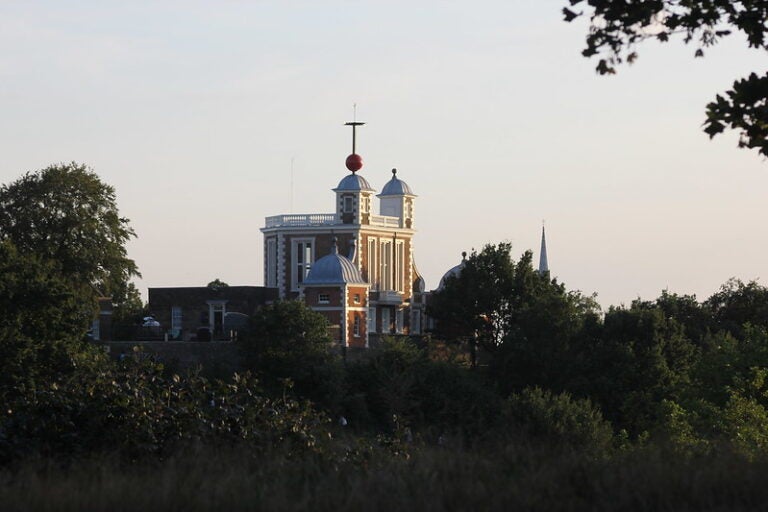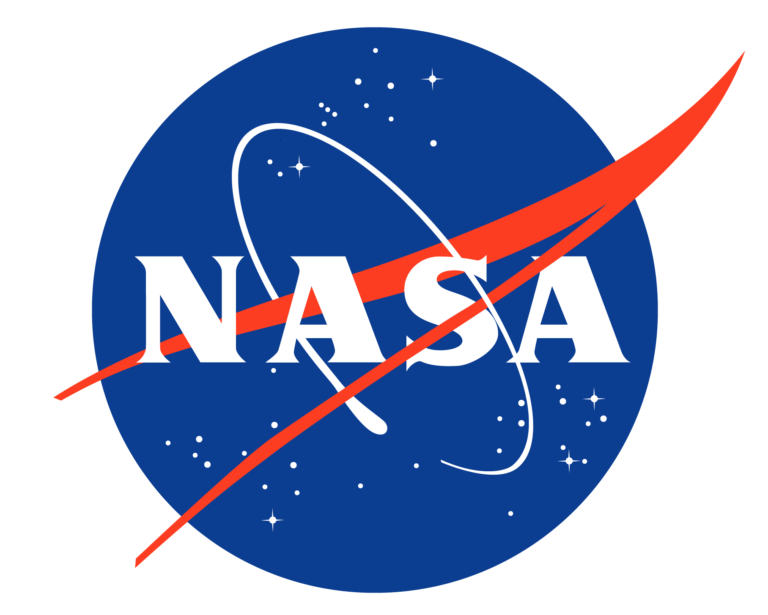Starmus was founded when May returned to school to finish his astrophysics doctorate, and one of his advisers was Israelian. Together, they decided: Why not put together a celebration of the things they loved — science and music? Thus, Starmus — stars plus music — was born.
Opening awards and music
The fifth Starmus Festival took place June 24–29, 2019, in Zurich, Switzerland. The event opened with a bang: an amazing orchestral music show coupled with the awarding of this year’s Stephen Hawking Medals for Science Communication.
The awards went to Elon Musk, for his visionary leadership of space exploration and associated outreach; celebrated musician Brian Eno, for his efforts with science popularization; and Todd Miller, director of the magnificent new documentary film Apollo 11. Additionally, Apollo 11 astronaut Buzz Aldrin received a lifetime achievement award. Eno, Miller, and Aldrin were on hand; Musk joined via video link from the Kennedy Space Center, where he was about to launch a Falcon Heavy rocket.
The renowned composer Hans Zimmer led the 21st Century Symphony Orchestra in a stirring series of anthems — titled “Once Upon a Time on the Moon” — throughout the evening. Musicians involved with the show included master of the keyboards Rick Wakeman and the guitar virtuoso Steve Vai. Astronaut Chris Hadfield performed a tribute to David Bowie with his rendition of “Space Oddity.”
Caltech’s Kip Thorne joined the orchestra to narrate a musical treatment reflecting on the nature of black holes. May then joined the festivities to hammer out, with the orchestra and his friends, renditions of the Queen songs “’39,” “Who Wants to Live Forever,” — in a tribute to the departed Stephen Hawking — and, as a closer, “We Are the Champions.”
Day 1
The normal Starmus routine commenced the next morning with talks, talks, and more talks. At the Samsung Hall in Zurich, some 1,500 people were in attendance. Chair of the day was Robert Williams, astronomer emeritus of the Space Telescope Science Institute and Starmus board member. (The Starmus board now consists of Israelian, May, Fadell, Williams, Emmanuelle Charpentier, Richard Dawkins, Peter Gabriel, Alexei Leonov, Jill Tarter, and me.)
The talks on this day involved reminiscences from Apollo astronauts, celebrating the 50th anniversary of the Apollo 11 landing. Speakers included Walt Cunningham (Apollo 7), Al Worden (Apollo 15), Charlie Duke (Apollo 16), Jack Schmitt (Apollo 17), Gerry Griffin (Flight Director on multiple Apollo missions), and Rusty Schweickart (Apollo 9).
Day 2
The next day, June 26, was the second full day of presentations, beginning with a 108-minute roundtable discussion to honor the 108 minutes of Yuri Gagarin’s initial manned spaceflight. The participants were Aldrin, Duke, Eno, Fadell, Michael Hintze, Israelian, May-Britt Moser, Schmitt, Donna Strickland, Worden, and moderator Griffin. The talks that followed, hosted by Tarter, were many and varied: Fabiola Gianotti on activities at CERN, home of the Large Hadron Collider; astronaut Tim Peake on his orbital experiences; Bob Smith, CEO of Blue Origin, on the future of private spaceflight; and astronaut Garrett Reisman on the future of human spaceflight.
Then, after a break, May and I delivered a 3D presentation, complete with viewing glasses handed to the audience, sharing stereoscopic views of Apollo images from our recent book, Mission Moon 3-D. After being joined by Duke for some firsthand accounts, we conducted a press conference about the book project. Following this came Fadell, who spoke on technology synergies between Earth and space, and Sir Martin Rees, England’s Astronomer Royal, who delivered a lecture on the prospects for humanity.
Day 3
The following day, June 27, I had the good fortune to play host for the festival. A large number of Nobel Prize winners were featured, along with astronauts and other scientists. First came Strickland, who spoke about high-intensity optical pulses; then Adam Riess, who described his work on the expansion of the universe; Williams and Claude Nicollier on the Hubble Space Telescope’s repair and scientific career; and astronaut Sandy Magnus on our next steps off-planet.
Day 4
On Friday the 28th, Starmus rolled on. The session chair on this day was Natalie Batalha, who introduced Martine-Nicole Rojina of the Sister Moon Project; Clive Neal, who spoke on getting back to the Moon; astronaut Nicole Stott, who described Earth from space through her art projects; Blackburn, who spoke on doing better science; and astronaut Helen Sharman, who discussed going from Mars to the stars.
Starmus is a relentless bath in intellectual wonder, moving from late morning each day to late at night, with talk after talk and hallway conversation after hallway conversation leaving one’s head spinning. It’s really the ultimate networking moment for the highest levels of astronomers, scientists, astronauts, techno wizards, musicians, and artists. And yet all of it is widely open to the public. Days of these amazing talks leave one almost overwhelmed but always hungry for more.
Day 5
The festival’s final day was no letdown. Saturday the 29th began with a special and quite amazing concert: The orchestra this time teamed up with Nobel Prize laureate May-Britt Moser, who walked us through the workings of the brain. She was accompanied by Vai on guitar. The Trondheim soloists joined in with a string chamber to give us a deep dive into the space, time, and memory of human brains. It was incredible.
Then session chair Brian Malow introduced the final day’s talks: Smoot on the history of cosmological research, Batalha on extrasolar planets and their discoveries with the Kepler Space Telescope, Barish on multi-messenger astronomy, and Charpentier on gene therapy. The last set of discussions consisted of a panel on life in the universe with Batalha, Dawkins, Michel Mayor, Rafael Rebolo, and Tarter. The final act of Starmus on Saturday night was a star party — not so much a viewing event, but a farewell party inside the Samsung Hall itself.
That’s a wrap
It’s not easy to calculate the value of the Starmus Festival. There’s nothing else like it in the world. We had most of the surviving Apollo astronauts on hand, as well as other astronaut-explorers, more than a dozen Nobel Prize laureates, many other important scientists, incredible rock and orchestral musicians, and artists of all types. The interchanges that take place at Starmus are priceless and lead to all manner of creative fallout. Such was the situation again at Starmus V in Switzerland. It left us all wondering how the next Starmus will top this one, as each successive festival has done. For more on the Starmus Festival, see www.Starmus.com.

